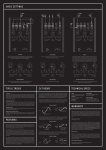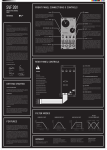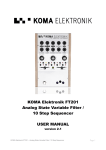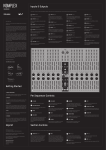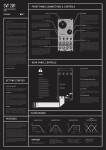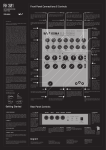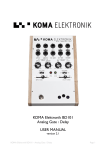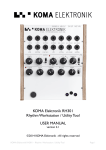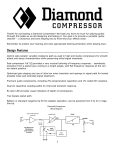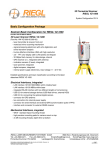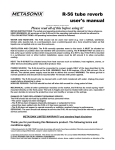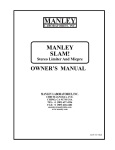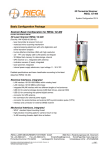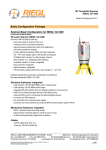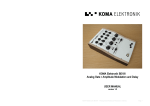Download FT 201 - KOMA Elektronik
Transcript
FT 201 FRONT PANEL CONNECTIONS & CONTROLS ANALOG FILTER/1O STEP SEQUENCER _ USER MANUAL The patch bay consists of ten 1/4” mono jack sockets used to send and receive various audio or control voltage signals. Blank arrows mark CV inputs/outputs, black arrows mark audio inputs/outputs. If the arrow is pointing towards the jack socket it shows you that this is an output. If the arrow is pointing away from the jack socket it is an input. The FT201 has been designed to accept unipolar CV signals only. Because the pedal runs on 9 V, every time you patch a control voltage to one of the CV inputs, the respective knob (e.g. SPEED knob or SPEED IN (CV input) determines the offset voltage of your CV input signal. (Audio Output) BAND PASS 1 The bandpass output of the filter. (CV Input) CUTOFF (Audio Output) LO PASS 6 The lowpass output of the filter. 7 SEQUENCER OUT (CV Output) The output of the sequencer, ranging from 0 – 7V. Note that this is the sum of the sequencer itself and the the CUTOFF knob. 2 Dear KOMA user, Filters are amongst the most important audio sculpting tools when it comes to defining your own unique sound. There’s a lot of discussion going on about different filter topologies, their respective sound and how to electronically solve these different approaches. At KOMA Elektronik, we went for a very versatile filter architecture called state variable filter. One of the advantages of this filter is that you have band pass, high pass and lowpass characteristics available simultaneously for a given input. Other musically convenient advantages are the independently adjustable Q (resonance) and gain that can be set without affecting other variables. There are two gain cells in the signal path of a voltage-controlled state variable filter so there are different approaches to represent those gain cells. Usually these gain cells are represented by an IC called ‘transconductance amplifier’ (a small chip) but for the FT201 we decided to take another electronic part here commonly known as ‘vactrols’. What is a vactrol? Basically it’s a light dependent resistor (LDR) and a LED kissing each other under a lightproof plastic blanket. When you send current through the LED, it shines brighter, therefore the resistance of the LDR decreases and vice versa. Vactrols are great for sound application because they are not prone to distortion and are known for their soft and organic, analog response and sound. Sequencers, on the other side, are great tools for modulation, possibly the most logical thing after a simple knob. With the onboard step-sequencer you can twiddle with charming frequencies and their resonant overtones or find a pretty pattern to go through your tone. With the sequencer output on the patch bay you can control other features of the pedal as well as other KOMA Elektronik pedals or synthesizers that accept control voltage. Combining these two sound tools brings up a whole new variety of defining your sound and playfully work with it. Have fun with your new machine! All the best from Berlin, The KOMA Elektronik Team Wouter Jaspers Christian Zollner Controls the cutoff frequency of the filter. When you insert a control voltage into this input the CUTOFF knob determines the offset voltage. (Audio Output) HI PASS 4 10 5 H A G Hayden Moskowitz GETTING STARTED resonance B The INPUT GAIN slider of the FT201 provides you with an adjustable gain to boost low level input signals. By sliding from left to right you can boost your signal from zero gain to 100 gain (0 to +20dB). Footswitch Cutoff Sets the cutoff frequency for the filter, simultaneously for all three filter characteristics. Fully counterclockwise sets the cutoff frequency to the lowest and fully clockwise to the highest frequency. F Robert Kunz SEQUENCER speed The SEQ. SPEED knob sets the speed of the sequencer: the time it takes to go from one step to the next one and at the same time also the duration of each single step (On the scale that means: 2 is the fastest, 10 is the slowest). If you turn the SEQ. SPEED knob fully counter-clockwise you can turn the sequencer off with a ‘click’ (there’s a built-in switch in the potentiometer). The sequencer of the FT201 consists out of 10 steps that you set with the 10 small knobs in the middle of the unit. It is easy to imagine these ten knobs as duplicates of the big CUTOFF knob, the amount set with the little sequencer knob of the active step is added to the current setting of the CUTOFF knob, or in other words: You can shift the sequencer CV up and down with the CUTOFF knob, similar to setting a bias voltage for incoming CV signals. You can use the sequencer CV Output on the patchbay to controls another function on the FT201 with CV or send it to another device. InpuT GaiN SENSOR (CVOutput) This is the CV output of the infrared motion sensor. The closer you move something towards the sensor, the higher the CV raises. You can set the sensitivity of the sensor with a small trimmer on the back called ‘Sensor’. The sensor output is 0 – 8V. Controls the amount of resonance in your given filter setting. When you insert a control voltage into this input the RESONANCE slider determines the offset voltage. Sequencer Steps AUDIO IN (Audio Input) The main audio input of the FT201. The sound source plugged in here will go through the whole effects section. 3 Accepts clock signals for the sequencer by overriding the internal clock set by the SPEED knob. It reacts to rising edge triggers, proceeding one step whenever a trigger or gate signal arrives. (CV Input) RESONANCE SEQ. RESET (CV Input) A rising edge trigger or gate signal arriving at this CV input resets the sequencer to step 1. A trigger will reset, and a gate will hold the sequencer at step 1 as long as it is high. 9 The highpass output of the filter. (CV Input) EXT. CLOCK 8 C Heavy duty Alpha foot switch turning the effect on and off. Seq. Length D The SEQ. LENGTH knob is a rotary switch that lets you choose the length of the sequencer pattern from 2 – 10; in other words, on what step that the sequencer will go back to step 1. The currently active step is indicated by a small red LED next to the step number. E Sensor Emits a CV signal that can be connected to any CV input on KOMA products or for example your (modular) synthesizer or other effect unit. By moving your hand over the sensor you can control the parameters of the CV input patched to it. Sets the Q of the filter, better known as resonance. The resonance of a filter determines the gain increase of the signal at the cutoff frequency. Set it to LOW (left) to leave the signal gain at cutoff frequency at zero and slide it to HIGH (right) to hear plenty of resonance at the given cutoff frequency. Be aware of the fact that the filter might start self-oscillating when you are at or near maximum resonance. 1. Unpack your machine The package comes with the FT201 pedal, a 9VDC, 500mA, center-negative power supply and this manual. Make sure that the power supply is rated for the line voltage of your country: 120 VAC for the USA, 220 VAC for Europe or most other countries. 2. Connect it Be sure your amp or mixer is turned off, then connect your instrument to the FT201 by using the AUDIO INPUT on the upper right of the patch bay. Connect one of the three filter outputs to your amp or mixer. REAR PANEL CONTROLS The FT201 is running on a +9V power supply. To make the unit compatible to all other equipment out there, we provide you with a trimmer for each CV input on the backside of the panel. So whenever you notice a significant distortion or clipping in your control signal waveform or strange CV behavior simply turn the trim pot counter-clockwise until you hear the desired result. By turning it counter-clockwise you attenuate the incoming CV signal. Fully counter-clockwise means that the incoming CV signal is completely trimmed down, whereas fully clockwise means that the incoming CV signal is arriving to the circuit unattenuated. 3. Set up the FT201 to a basic patch Set all the rotary controls on the FT201 to 0. Turn down the volume of your amplifier. 4. Power up / Bypass Connect the FT201 power supply to the FT201 DC input on the backside of the pedal. When you press the bypass switch the EFFECT ON/OFF led will light up, this means the effect is ON. 5. Set levels Sensor CV Out Adjust the sensitivity of the motion controller. Sensor CV Out Attenuates the outgoing CV signal of the Sequencer. Resonance CV In Attenuates the incoming CV signal. DC Power Connector: Use only KOMA PSU to ensure high quality performance. Cutoff CV In Attenuates the incoming CV signal. Make sure the EFFECT ON/OFF indicator is OFF. Play your instrument and adjust the volume. Press the Bypass switch and the EFFECT ON/OFF indicator will turn green which means the effect is now active. If necessary, adjust the INPUT GAIN control to match the levels of the processed signal and the bypassed signal. 6. Play Now play that machine! Be aware of volume changes in your signal when using the FT201. Make sure that when you plug in the unit the RESONANCE slider control is not fully set to HIGH, this to avoid very loud and very high pitched sounds while sound checking (or you might just be really into that, in that case, leave it up high and roll with it). IMPRINT KOMA Elektronik GmbH is a subsidiary company of KOMA Elektronik B.V. Vertretungsberechtigte Geschäftsführer / Managing Director: Christian Zollner & Wouter Jaspers Sitz der Gesellschaft / Registered Office: Berlin, Germany Registergericht / Court of Registration: Amtgericht Berlin-Charlottenburg Registernummer : HRB 145453 Umsatzsteuer ID / VAT ID: DE285522050 KOMA Elektronik GmbH Mahlower Strasse 24 12049 Berlin-Neukölln Germany BASIC SETTINGS AUDIO OUT AUDIO TO MIXER AUDIO IN AUDIO OUT AUDIO IN FROM DAW OSCILLATOR 3 MIXER CHANNEL CLICK IN Patch the HI PASS output back into the AUDIO input to create an oscillator. Sequence the pitch and even hold the sequencer when you place your hand over the SENSOR that is patched into SEQ RESET. Take each output channel into its own channel on a mixer to blend between each filter type manually. Use a loud click signal, i.e. a short kick or rim shot, to clock the sequencer of the FT201 via the EXT CLOCK CV input. You can use a signal from your DAW or drum computer. We offer a few examples (Ableton Live and WAV format) on our website. SUB BASS RESONANCE DEEP BASS PUNCH DISTORTED LOW FREQUENCIES (great for bass synths) When using the HI PASS output at a very low cutoff and high resonance, sub bass frequencies are added around the Q frequency. Plug your amp into the LO PASS output. When the input gain is all the way up, the signal is distorted along with high resonance, creating a gritty sound. TIPS & TRICKS CV THEORY TECHNICAL SPECS Linear PSU The concept of control voltage (CV) is not hard to understand: instead of turning a knob on your pedal, you simply connect a voltage – the control voltage – to the corresponding CV input that does the job for you. For example, if you want to have quickly varying RESONANCE, you don’t have to turn that knob back and forth rapidly until your fingers fall off but simply connect an alternating CV to the RESONANCE CV input. Casing Powder coated aluminum casing, silk screened text and wooden side panels. To ensure the best sound quality we recommend using a linear power supply at all times. Because the sensor circuit needs a lot of current, we recommend a minimum of 500mA. Since it’s a linear power supply, not switching, make sure the power supply is rated for the line voltage of your country: 120 VAC for the USA, 220 VAC for Europe and most other countries. How to clean your FT201 The FT201’s body is white, which means the chance of it becoming dirty after a show or intense studio session is high. To clean the pedal, use some pure cleaning alcohol (e.g. isopropyl). Make sure you use it safely, that stuff is pretty flammable. Also make sure there is no solvent mixed in, this will remove the screen printing on the pedal. You can take control signals from any source for controlling the inputs of the FT201. All of the CV inputs theoretically accept control voltages from -100V to +100V though a range from -5V/-12V/-15V to +5V/+12V/+15V is more common and usable. Dimensions 23 cm x 15 cm x 5 cm (L x W x H) / 9" x 6" x 2" (L x W x H). Shipping Weight 1 kg / 3.0 lb including power adapter and instruction manual. Power requirements 9V DC power adapter, 500mA min, center polarity negative (only use the KOMA adapter shipped with the pedal). BIPOLAR CV SIGNALS Cleaning the Sensor After intensive use the sensor can be a bit dusty, we recommend to clean the sensors with a simple old toothbrush. WARRANTY Manipulating the Sequencer Length The FT201’s internal sequencer can officially only run from 2 - 10 steps. Try to challenge this principle by setting the SEQ LENGTH controls to 1. We think this feature is very useful! FEATURES The incoming bipolar CV signal is shifted around the voltage that you select with the corresponding knob. Example: if you insert a -5V to a +5V sine wave into the CUTOFF CV input you will get the following results while turning the CUTOFF knob: KOMA Elektronik warrants its products to be free of defects in materials / workmanship and conforming to specifications at the time of shipment for a period of two years from the date of purchase. During the warranty period any defective products will be repaired or replaced at KOMA Elektronik’s option on a return-to-factory basis. This warranty covers defects that KOMA Elektronik determines are no fault of the user. BIPOLAR CV SIGNALS Returning your product? You must obtain prior approval in the form of a RMA (Return Material Authorization) number from KOMA Elektronik before returning any product. Email us at [email protected] to request the RMA number. All products must be packed carefully and shipped with the KOMA Elektronik supplied power adapter. Sorry, the warranty will not be honored if the product is not properly packed. Once you have received the RMA#, write it on the box together with the word: WARENRUCKSENDUNG and carefully pack your product, ship the product to KOMA Elektronik with transportation and insurance charges paid, and include your return shipping address. The use of the filter section of the FT201 is pretty straight forward. There is the CUTOFF knob with which you set the cutoff frequency for the filter, simultaneously for all three filter characteristics. Fully counter-clockwise sets the cutoff frequency to the lowest and fully clockwise to the highest frequency. The RESONANCE slider sets the Q of the filter, better known as resonance. The resonance of a filter determines the gain increase of the signal at the cutoff frequency. Set it to LOW (left) to leave the signal gain at cutoff frequency at zero and slide it to HIGH (right) to hear plenty of resonance at the given cutoff frequency. Be aware of the fact that the filter might start self-oscillating when you are at or near maximum resonance. The sequencer is divided into two parts: A control section and the actual sequencer itself. The control section consists of the two knobs named SPEED and SEQ. LENGTH. The SPEED knob sets the speed of the sequencer which means the time it takes to go from one step to the next one and at the same time also the duration of each single step (On the scale that means: 2 is the fastest, 10 is the slowest,). If you turn the SPEED knob fully counter-clockwise you can turn the sequencer off with a ‘click’ (there’s a built-in switch in the potentiometer). A similar thing happens to unipolar CV signals: their point of origin (0V) is shifted by the amount set with the corresponding knob. In other words: you add the voltage of your knob to the voltage of your incoming unipolar CV signal. UNIPOLAR CV SIGNALS What will we do? Once received, we will examine the product for any obvious signs of user abuse or damage as a result of transport. If the product has been abused, damaged in transit, or is out of warranty, we will contact you with an estimate of the repair cost. Warranty work will be performed and KOMA Elektronik will ship and insure your product to your address free of charge. How to initiate your warranty? Please initiate your warranty online by sending an email to: [email protected] Graphics by: www.rabadaun.com


